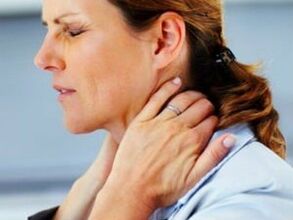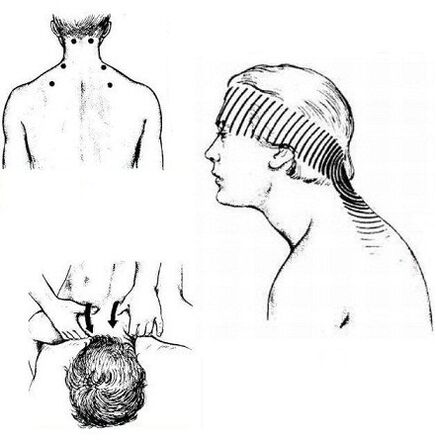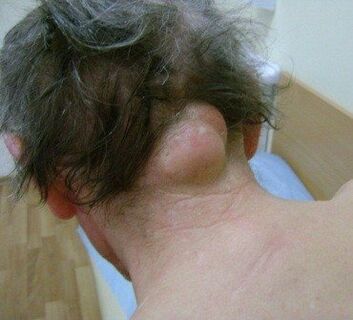
The neck of humans, like other animals, is an amazing part of the body, rather fragile, but powerful.
The cervical spine, with all the muscles and ligaments, supports and moves the skull, absorbs shock when walking, protects the brain from concussions, protects the blood vessels that feed it and also protects the spinal cord.
It can be said that almost everyone has suffered from neck pain throughout their life. Neck pain can affect men and women at any age.
When the neck hurts, the reasons can be quite varied. Some of them can self-absorb within a few days and others can cause chronic pain and illness.
Why does the pain occur?
The most common reason your neck hurts is poor posture. With a hunched back, the head ceases to occupy a position exactly above the body and moves forward. In this position, the muscles and ligaments of the neck experience increased tension. The development of back and neck pain is facilitated by prolonged work without changing position, sleeping on a soft bed or high pillow, prolonged static load.
Other causes of neck pain are injury resulting from a head-first fall, traffic accident, or playing sports. With strong acceleration and then braking, the cervical spine makes a whiplash movement. As a result, ligaments and muscles can become too stretched, displacement or compression fracture occurs in the cervical vertebrae, and the formation of intervertebral hernias.
Neck pain can occur as a secondary manifestation of other illnesses. For example, with a heart attack, when a heart attack causes severe pain, radiating along the nerve plexuses to the upper limbs, chest, neck. Neck pain with a heart attack is only part of a large symptom complex - shortness of breath, sweating, nausea, vomiting. If your neck, jaw hurts, and other signs of a heart attack are observed, you should immediately call an ambulance.
Neck pain is also used as a diagnostic sign of meningitis. With this disease, the muscles of the neck become hypertonic, that is, they become rigid. When you try to tilt your head towards your chest, the back of your neck hurts a lot.
The spine in the neck area hurts with rheumatoid arthritis, osteoporosis, fibromyalgia, spondylosis and osteoarthritis, hernia or protrusion, with compression of the nerve roots or spinal cord with infectious edema, abscesses, tumor or benign neoplasms.
Special cases
Degenerative diseases
Osteochondrosis, or, in other words, dystrophic disorders of the intervertebral discs, leads to the fact that a person's neck constantly hurts. This is usually mild pain, often accompanied by a feeling of numbness and pain in the shoulder girdle and head.
The area of the cervix affected by osteochondrosis can cause the development of cerebral artery syndrome. With a decrease in intervertebral distances in this area, a compressive lesion of the vertebral arteries occurs in the openings of the transverse processes of the cervical vertebrae. Pressure on the vessel causes decreased blood flow to the brain with the onset of dizziness, decreased vision and hearing. On the other hand, the mechanical stimulation of the artery with the pressure of the vertebrae causes a reflex spasm, which is manifested by a burning throbbing pain in the head.
Processing
If the neck constantly hurts against the background of osteochondrosis, treatment begins with the elimination of the pain syndrome. The second mandatory direction of treatment is to stop degenerative processes in the cervical vertebrae.
Pain relief can be obtained using the following groups of drugs:
- nonsteroidal anti-inflammatory drugs - directly block the cascade of mediators that signal pain;
- muscle relaxants - eliminate muscle spasms resulting from severe pain;
- sedatives - they soothe and inhibit the nervous system and the transmission of painful impulses, especially (valerian, antidepressants, sleeping pills);
- vasodilators - help eliminate vertebral artery syndrome and the pain associated with it.
To eliminate the cause of neck pain in osteochondrosis, chondroprotective drugs are prescribed that prevent the destruction of cartilage and vertebrae, as well as multivitamin mineral complexes.
Pain management also includes physical therapy, physiotherapy, massage, traction, reflex, and taping therapy. During an exacerbation, in order to relieve pain, the patient is advised to wear a special collar that protects the neck from excessive mobility.
Muscle pain

Pain in the neck can occur when the muscles in the neck become inflamed, called myositis.
Such pain should be distinguished from neuritis (inflammation of the nerve trunks with sensory disturbance) and pain caused by osteochondrosis.
Myositis occurs suddenly, after exposure to predisposing factors - hypothermia, vibrations, prolonged overwork, especially with prolonged repetitive movements of the same type.
Cervical myositis is characterized by a sharp pain that occurs when the inflamed muscle contracts. The high severity of the pain makes it difficult to perform certain types of movements.
Usually, the long muscles of the neck on the anterolateral surface or the sternocleidomastoid muscles hurt, which with bilateral contraction pull the head back, and with unilateral contraction turn it.
The deep muscles that surround the spine are also often inflamed and put the entire neck and back in motion.
When probing a muscle, its increased tone and dense gnarled areas are noted. Violation of microcirculation and local trophism leads to the gradual replacement of myocytes with connective tissue. As a result, the neck muscles weaken, their symmetry is broken on the sides of the spine, stiff neck may appear, and it is difficult for the patient to keep the head upright.
Processing
Treatment begins with reducing the strain on the neck. This is followed by a course of physiotherapeutic procedures - heating with UHF, electrophoresis with drugs, heating with paraffin, wrapping with ozokerite, diathermy, massage, acupuncture. Such procedures restore blood circulation to the muscles of the neck. Among the drugs, injections of B vitamins, anti-inflammatory drugs and pain relievers, ointments and rubs are prescribed.
An alternative treatment recommends using cabbage or burdock leaves as analgesic compresses, preparing an ointment from willow buds pounded in butter, making a rub from a mixture of turpentine with apple cider vinegarapple and egg yolk. Further, the neck is rubbed with lava oil, and then wrapped. The main guarantee of the success of any treatment is to keep the sore neck calm until its muscles are fully restored. Then you should start to return them "to duty" by means of special gymnastics and massage.
Radicular syndrome
Severe neck pain, which spreads to the muscles of the head, shoulder girdle, and upper extremities, can occur when the roots of the spinal nerves are pinched during a prolapse, protrusion, or herniated disc.
With this disease, the inner nucleus of the disc protrudes towards the spinal canal or its lateral horns. A hernia and its symptoms usually appear on one side. When pressure is created on the roots of the spinal nerves, a sharp, burning pain appears in the innervated muscles (cervical lumbago). The patient feels numbness in the lower jaw, the area around the ears, the back of the head, shoulder blades, arms. Dizziness appears, severe pain in the neck when changing position from horizontal to vertical. The gradual protrusion of the disc nucleus leads to trauma to the surrounding tissues, their inflammation and edema. This creates the prerequisites for the inflammation of nerve endings with the development of radiculitis, the mobility of the neck and upper extremities is gradually limited. Prolonged damage to the spinal nerves leads to paresis or paralysis of the limbs.
Therapy
What to do if the neck hurts with a hernia? At home, with pain syndrome, pain relievers, nonsteroidal anti-inflammatory drugs, hormonal drugs, muscle relaxers are taken to relieve spasms.
In the hospital, severe neck pain is removed with the help of "blockages" - the introduction of anesthetic substances to the sides of the spine.
The swelling and inflammation are treated with steroids which can be injected directly into the hernia. Muscle pain is eliminated by taking muscle relaxants.
In addition, to prevent the further development of the hernia, I use drugs that strengthen cartilage tissue - chondroprotectors.
In many cases, therapeutic exercises and traction traction of the cervical spine with a protrusion or a slight protrusion help. The increase in intervertebral space helps in "retraction" of the intervertebral disc and relieves pressure on the nerves.
In a true hernia with rupture of the fibrous ring and prolapse of the nucleus in the spinal canal, surgery is necessary. There are several ways to get rid of neck pain through surgery:
- anterior cervical discectomy - removal of an extra piece of disc that presses on the spinal nerves;
- replacement of the damaged disc with an artificial joint, which protects the cervical spine from further destruction;
- microendoscopic dissectomy using a posterior approach and removal of small areas of hernia using an endoscope;
- posterior cervical dissectomy through an incision in the back of the neck. The operating channel is specially enlarged so that the pinching does not develop in the future.
Tumors

If there is a constant pressing pain in the neck, one can suspect the appearance of a foreign education in this department.
Benign or malignant neck tumors can occur in the vertebral body, blood vessels, epithelium, connective, nervous, fatty, or glandular tissue.
Benign tumors (lipoma, fibroma, neuroma, osteoma, hemangioma) are most often of correct shape and clearly limited, they rarely cause pain. The discomfort is mainly associated with the compression of the surrounding tissue by the tumor. Malignant tumors (osteosarcoma, myeloma, cancer of the lymph nodes or of the thyroid gland) have no borders, they give a lot of metastases to neighboring tissues. Their destructive effect on the organs causes a painful sensation, a general deterioration of the condition. The front of the neck may have cancer of the larynx, throat, oral organs, and thyroid gland. The patient has difficulty swallowing, there is swelling of the neck and face, a change in voice. If the neck flight hurts with a bone tumor, then this condition also often accompanies damage to the spinal cord and nerve roots on the side of the spine with the development of paralysis.
Processing
Treatment of pain in neoplasms is primarily aimed at eliminating the cause - reducing or eliminating swelling. For this purpose, chemotherapy and radiation therapy, hardening of the vessels supplying the tumor and surgical removal of the pathological formation are used.
Pain relief depends on the severity of the pain:
- weak pain relievers;
- analgesics of moderate severity;
- with increasing pain, they switch to weak opiates;
- with severe pain, analgesia is possible only with the help of opioid drugs. To improve analgesia of pain in the neck with neoplasms, antipsychotics, anticonvulsants and corticosteroids are used.
To note! Neck pain can occur for a variety of reasons. In order not to miss serious illnesses, it is first of all necessary to consult a doctor for a consultation on the appearance of pain and the exact determination of its source.























